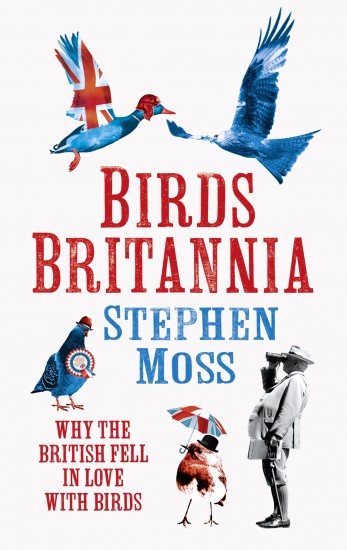a book by Stephen Moss.
Reviewed by Ceri Levy.
Recently BBC4 ran a wonderful series entitled Birds Britannia, which explored the British attitude towards, and relationship with, birds. Divided into four parts, covering Garden Birds, Waterbirds, Seabirds and Countryside Birds, the programmes reflected upon and examined every nuance of our bond with our avian neighbours. If there were a criticism that could be levelled at the series, it would be that the programmes weren’t long enough. Modern television demands a certain pace and because of this there was hardly time to pause and reflect on whatever new nugget of a story had just been revealed, or to digest the next thought provoking opinion from one of the series’ wonderful cast of characters who populated our TV time so well for an hour every week for a month. I just wanted more time with these programmes and their subjects. I wanted the Director’s Cut of Birds Britannia.
Stephen Moss, producer of the TV series, has now donned his other hat as writer, and produced just what I wanted. This book is an accompaniment to Birds Britannia, although it is not necessary to consider it as such. Written after he had completed the series he elaborates on and expands many of the stories from the programmes allowing the reader the opportunity to soak up the stories we had become familiar with on TV and a whole lot more. Thoughts, stories and ideas pour forth from Moss and his heavyweight cast, including Mark Cocker, Tim Birkhead, Jeremy Mynott, Rob Lambert, Desmond Morris, Tony Soper, and David Attenborough.
Birds Britannia tells the tales of some very dark moments in our bird stories. Man has used birds in all sorts of ways from fashion items to birdsong competitions to being pets and companions. We have constantly hunted and killed birds for food and sport, but as Stephen says:
“… during the course of the twentieth century, and into the new millennium, our passion for birds took a more benevolent, and less destructive, direction. This was through the hobby, pastime or obsession (call it what you will) of birdwatching – or birding, as it is now more usually known. Again, Britain leads the world: with more than one million members of the RSPB, half a million people taking part in Citizen Science projects such as the Big Garden Birdwatch, and tens of thousands of enthusiasts actively going out to watch birds every weekend. Along with sport, cookery and gardening, birding has now become one of our major leisure activities, and in a world where our concern for the environment is growing, its popularity looks set to continue.”
From the Victorian era through the wars to the present day, birds have been utilised by us in so many ways including being the bearers of wartime propaganda messages such as in the 1944 film ‘Tawny Pipit’ in which two rare breeding tawny pipits are discovered in an idyllic English village and need protecting from many dangers including tanks and a dastardly egg-collector. There is a recovering airman, who along with the villagers protects the birds and he recovers and is ready for service again when the chicks hatch and fledge. It’s a simple tale of good over evil and everyday folk winning through but what I love most is that a rare tawny pipit is exactly what it says it is, a rarity. For Eric Hosking, who had to film meadow pipits instead of tawny pipits, this proved a nightmare as he could only film the birds from behind because from the front their heavily streaked breasts would give the game away as to their real identities. But for those that are in the know, a meadow pipit will never be a tawny pipit although I am sure that people often do still try to turn them into such every now and again when out in the field.
Stories of birds roll from the pages, not all of them portraying humans in the best light. For example, how our ever-changing relationship with the sparrow evolves, being in turn friend or foe and nowadays friend again as it disappears from our city streets. It is hard to believe that as recently as the First World War that the sparrow became Public Enemy Number 1. Having long been hated in the countryside because it ate grain supplies, it was feared that the bird would destroy food supplies in the city and was suddenly considered as vermin as opposed to a chirpy friend in the garden that needed feeding. (The feeding of garden birds had become outlawed during wartime). Sparrow clubs were set up in neighbourhoods and their main purpose was to reward the killer of the most sparrows in a year with a cup. Odd stories such as this appear throughout the book and one feels that only the British could have such a yo-yo relationship with birds and merit such a book as engaging and worthwhile as Birds Britannia to be written.
The last word goes to Stephen and James Fisher, the naturalist, on why we enjoy watching birds so much.
“As to why we enjoy watching birds so much, perhaps it is because it appeals to many different human impulses and instincts, as (James) Fisher rightly pointed out: ‘The observation of birds may be a superstition, a tradition, an art, a science, a pleasure, a hobby, or a bore; this depends entirely on the nature of the observer.’ Birds Britannia explores this eclectic passion, taking us on a journey from exploitation, through appreciation, to delight.”
The Birds Britannia series is repeated on BBC 4 from Tuesday April 12th
Birds Britannia (hardback) is now on sale in the Caught by the River shop, priced £12.50
